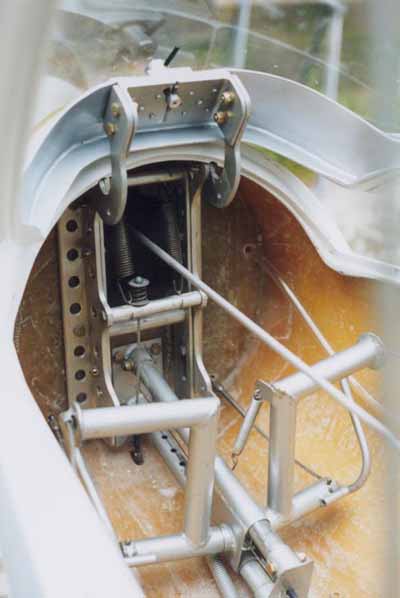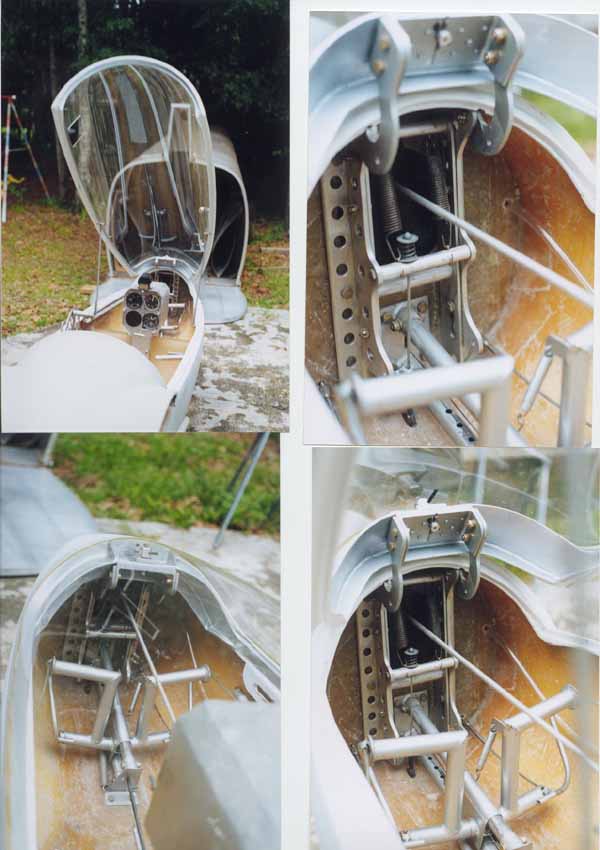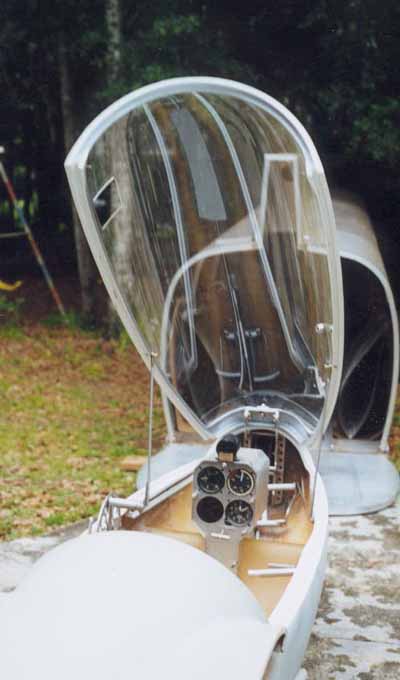
HP-18 Single Canopy Mechanism
By Hugh Gardner

I made a one-piece canopy with forward hinge for my HP-18 a while back and a few people wanted to see it. I never made any drawings, it was trial and error, and I no longer have the glider here to give exact dimensions. So to the best of memory:
It all started with the one piece Plexiglas canopy that I got it from Schreder. The canopy frame was molded right to the canopy opening. This was a major job. The "tongue n groove" design used in modern glass ships designs was chosen in order to ensure a good seal.
First the cockpit opening had to be modified. This was accomplished by routing out some PVC foam into about a 1/2" or less quarter round moldings. The foam was fastened around the canopy opening, 'glassed' into place, filled, primed and then spray painted. The modified opening was waxed, waxed and re-waxed to keep canopy frame glass from sticking. Then I taped vinyl, like the vinyl siding on houses, flush with fuse sides and around turtle deck and nose. (Glass will not stick to this vinyl.) Another strip of vinyl taped to inside cockpit opening making frame about 1" wide, building a trough. Strips of cloth were laid in the trough and wetted with resin until it was about 3/4 inch thick. A piece of aluminum angle trimmed up and laminated into the nose section of frame for hinge mount.

Once frame was built up it was broken loose a space was routed out the thickness of Plexiglas in frame upper or inner half leaving some frame for a perfect fit to fuse sides. The canopy was trimmed and glued in place. (Editors Note: The routing process can be eliminated by attaching strips of 'off set wax', the thickness of the Plexiglas, to the vinyl prior to lay up.)
I went to a glider contest and walked around looking at all the factory gliders with forward canopies and got some ideas. After a lot of experimenting, cutting wood, cardboard templates and parts, (wasting a lot of metal) I finally had something that worked, even though final adjustments and details were still needed when I sold it.

The only way to keep the canopy from gouging into the fuse was to raise the hinge about an inch or so then tilt forward. To do this I built a vertical track that the hinge rides on (sort of like a jack plate on the back of an outboard boat to raise and lower the motor). Two springs pulled this mechanism up while a cable attached to a lever in cockpit pull it down. The lever is mounted near canopy vent window to allow access from outside the cockpit. At the same time the lever that pulls a cable toward the nose to pull down the hinge track, it pulls or pushes a rod that activates 2 latches on a torque tube across the cockpit behind your head that latch the canopy shut on both sides in the rear of canopy. To hold the canopy open, I laminated a trimmed piece of angle aluminum to the underside of cockpit opening with a slot milled into the vertical part. I had stay rods attached to canopy frame via stud glued into frame hiem joint on that wnd of rod a offset plate welded to another rod with bolt going through small R/C helicopter bearing riding in slot. The rod is telescoping for emergency release, part of the rod stays on canopy the other one stays on the fuse, cut to right length that gravity holds it in place but it can pull apart. The emergency hinge release, a whole other ball game. Oh, I also installed screen door springs to help me open the canopy and holding it open. They are attached to the bottom stayrod bearing in the slot. The canopy is released from the hinge in emergency by a lever on the right side frame, like a Blanik L-13, the lever pulled a cable that turnes a 1/4 turn type of screw that let the canopy frame loose from hinge. I think I got that idea from looking at a Ventas